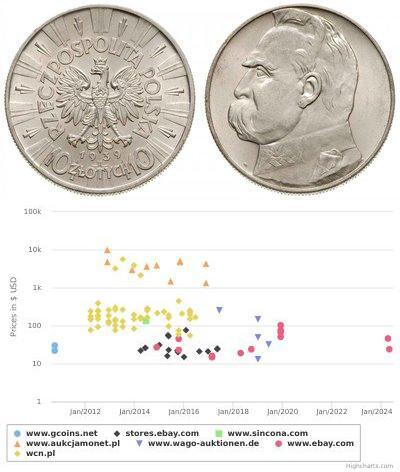(sold for $45.0)
1900, Stuttgart (City). Silver "Heilbronn Grammar School" Award Medal. NGC MS63!
Mint Year: ca. 1900 Mint Place. Stuttgart Reference: Kaiser 9. Condition: Certified and graded by NGC as MS-63! Denomination: Award Medal - Heilbronn Grammar School Weight: 10.72gm Diameter: 27mm Material: Silver
Obverse: Star above classical oil-lamp.
Reverse: Inscription in four lines separated by decorative element. Legend: VIRTUTI ET INDUSTRIAE GYMN. REG. STUTTGART.
Heilbronn is a city in northern Baden-Württemberg, Germany. It is surrounded by Heilbronn District and, with approximately 123,000 residents, it is the sixth-largest city in the state. The city on the Neckar is a former Imperial Free City and is the seat of Heilbronn District. Heilbronn is also the economic center of the Heilbronn-Franken region that includes most of northeast Baden-Württemberg. Furthermore, Heilbronn is known for its wine industry and is nicknamed Käthchenstadt, after Heinrich von Kleist's Das Käthchen von Heilbronn. Heilbronn is the seat of the main campus of the Hochschule Heilbronn, founded in 1961 as a public engineering school. Since 1971 the school was known as the Fachhochschule Heilbronn (Heilbronn University) and has operated a secondary campus in Künzelsau since 1988. Starting with the fall semester on September 1, 2005 the Fachhochschule was awarded the status of a Hochschule. City grammar schools are the Damm-Grundschule, Deutschorden-Grundschule Kirchhausen, Grundschule Horkheim, Grundschule Klingenberg, Grünewaldschule Grundschule Böckingen, Reinöhlschule Grundschule Böckingen, Silcherschule Grundschule and Uhlandschule Grundschule Sontheim. Grammar and middle schools (some include vocational training programs) are Albrecht-Dürer-Schule Neckargartach, Elly-Heuss-Knapp-Schule Böckingen, Fritz-Ulrich-Schule Böckingen, Gerhart-Hauptmann-Schule, Grund- und Hauptschule mit Werkrealschule Biberach, Grund- und Hauptschule mit Werkrealschule Frankenbach, Ludwig-Pfau-Schule, Rosenauschule, Staufenbergschule Sontheim, Wartbergschule and Wilhelm-Hauff-Schule.
Gymnasium (German plural: Gymnasien), in the German education system, is the most advanced of the three types of German secondary schools, the others being Realschule and Hauptschule.
For Johann Joachim Becher, education also had the mandate to support the replacement of the Holy Roman Empire with a more republican commonwealth. His school would have had the task of creating education and teaching an organized state structure. His ideal was the artisan, the educated scholar, the universal scientist.
In the German secondary school system, Realschule is ranked between Hauptschule (lowest) and Gymnasium (highest). After completing the Realschule, good students are allowed to attend a professional Gymnasium or a general-education Gymnasium. They can also attend a Berufsschule or do an apprenticeship.
In most states of Germany, students start the Realschule at the age of ten or eleven and typically finish school at the age of 16–17. In some states, Realschulen have recently been replaced by Oberschulen or Sekundarschulen. In 2006 1.32 million German students attended a Realschule.
At Realschule, a student gets an extended education and learns at least one foreign language, usually English. In the state of Baden-Württemberg, after the sixth grade, the student has to choose among technology, home economics, and a second foreign language, usually French. The new subject becomes the student's fifth main subject, after German, maths, science and English; and it is also possible to learn other foreign languages in free workshops. Other subjects are geography, social sciences, economics, history, religious education, and physical education. After the 8th grade a student has to choose between arts and music.
High school diplomas obtained in Canada or the United States are usually acknowledged as a Mittlere Reife (graduation from a Realschule). In some cases however students may apply for certain subjects at a university. All students holding an American high school diploma may apply for the Studienkolleg, and after successfully graduating from this they may attend a German university. Those holding a high school diploma can choose from a wider range of possible major subjects at a German university if they did well on the SAT or ACT. Those who scored higher than 1300 on the SAT or higher than 28 on the ACT may apply for any subject at a German university.
Gymnasia and Realgymnasia are the classical higher or secondary schools of Germany.
Starting in 2010/2011, Realschulen were formally abolished in Berlin and merged with Hauptschulen and the old Gesamtschulen to form a new type of comprehensive school, called Stadtteilschule in Hamburg and Sekundarschule in Berlin.
Only 1$ shipping for each additional item purchased!

|
Posted by:
anonymous 2021-02-03 |
303 coin descriptions were improved from 2024-04-17 to 2024-04-24
One of them is:
1 Real Republic of Guatemala (1838 - ) S ...
group has 3 coins / 1 prices








-300-150-84_BwcI0zyMAAAEq6fJDRaZN.jpg)





